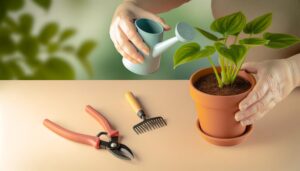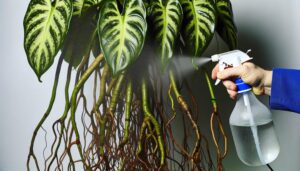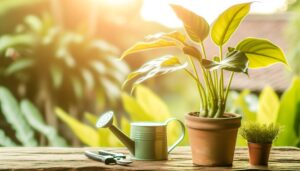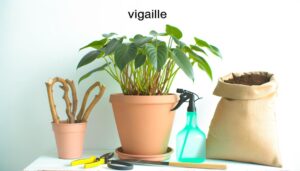How Do I Care for a Hope Selloum Philodendron? Expert Tips
Hope Selloum Philodendron, a tropical plant native to South America, requires specific care for best growth. Position it in bright, indirect light, avoiding direct sun which can burn its leaves.
It thrives in daytime temperatures of 65-78°F (18-25°C), with a relative humidity of 40-60%. Soil should be well-draining, slightly acidic, and rich in organic matter.
Regular watering is necessary, ensuring the soil remains moist but not waterlogged. Prompt treatment of common pests and diseases is crucial.
Careful repotting and propagation methodologies also contribute to plant health. For an in-depth understanding of these care steps, proceed further.
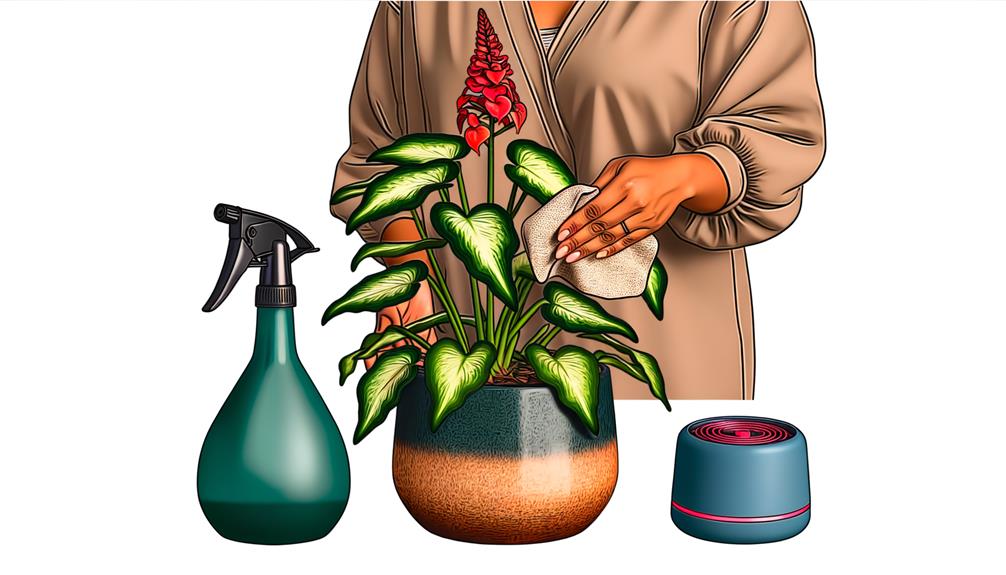
Key Takeaways
- Place your Hope Selloum Philodendron in bright, indirect light, avoiding direct sunlight to prevent leaf burn.
- Maintain a consistent temperature of 65 to 78°F (18-25°C) and a humidity level of 40-60% for optimal plant health.
- Water the plant when the top inch of soil is dry, ensuring the soil is moist but not waterlogged to prevent root rot.
- Use a well-draining soil mixture rich in organic matter with a slightly acidic pH (6.0-7.0) for ideal growth.
- Monitor the plant regularly for pests like aphids and mealybugs, treating any infestations with insecticidal soap or neem oil.
Understanding the Hope Selloum Philodendron

The Hope Selloum Philodendron, scientifically known as Philodendron bipinnatifidum, is a tropical plant native to South America, renowned for its large, glossy, dark green leaves and its resilience in various indoor environments. This plant, part of the Araceae family, thrives in well-drained soil and prefers a humid atmosphere, mirroring its tropical home.
Its size can range from 1.5 to 2 meters tall, making it an impressive addition to any indoor setting. It is a perennial plant, displaying long-lasting importance and endurance. Its propagation is typically achieved via cuttings, while its care demands a moderate watering routine.
To serve others effectively in caring for this plant, understanding its native habitat, growth patterns, and care requirements is essential.
Optimal Lighting Conditions
Regarding lighting, the Hope Selloum Philodendron thrives best in bright, indirect light, a vital condition for its growth and well-being. Direct sunlight can burn the leaves, while low light can stunt growth and cause leaves to become pale.
To illustrate, consider the following table:
| Light Intensity | Effect on Plant | Ideal Location in Home |
|---|---|---|
| Direct Sunlight | Burns the leaves, causing them to turn brown | Not recommended |
| Bright, Indirect Light | Promotes healthy growth and vibrant green leaves | Near a north-facing window or a few feet away from a south or west-facing window |
| Low Light | Stunts growth and causes leaves to become pale | Not recommended |
Ideal Temperature and Humidity
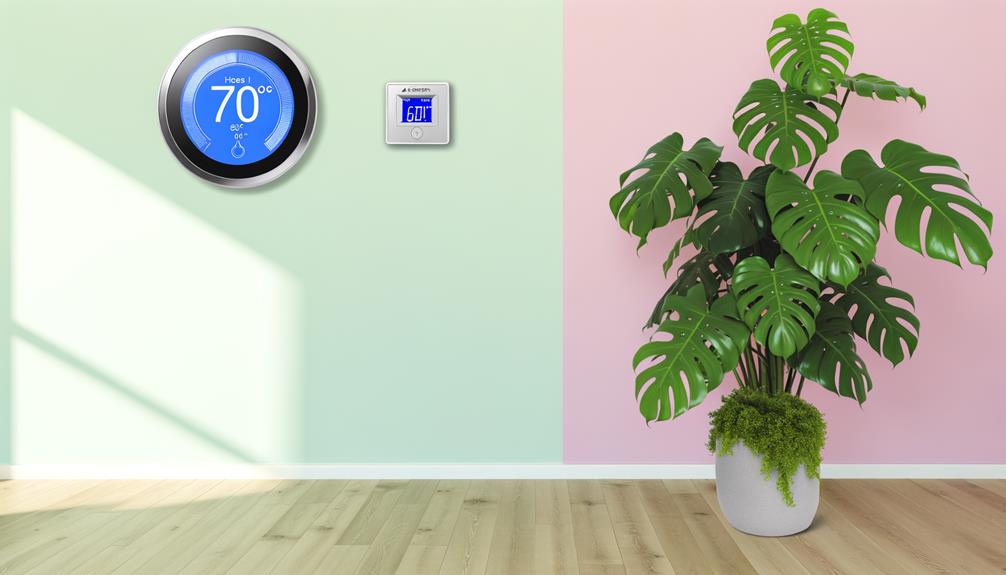
In the intricate dance of indoor plant care, temperature and humidity play essential roles in the health and vigor of the Hope Selloum Philodendron.
Scientists have found that this tropical species thrives in daytime temperatures of 65 to 78°F (18-25°C), and nighttime temperatures 10 to 15 degrees lower. A sudden drop or rise beyond these parameters can cause leaf yellowing or drop.
As for humidity, the Hope Selloum appreciates a relative humidity of 40-60%. Below this, leaf tips may brown, and above, fungal diseases may proliferate. In dry environments, a humidifier or pebble tray with water can increase humidity. In damp climates, good ventilation can prevent excess moisture.
With these conditions, your philodendron can flourish.
Watering Your Philodendron
While maintaining the right temperature and humidity is vital, equally important is understanding the proper watering techniques for the Hope Selloum Philodendron. This tropical plant thrives when its soil is kept consistently moist, but not waterlogged. An over-saturated soil can lead to root rot, a potentially lethal condition for this species.
Conversely, underwatering can result in leaf wilting. Regarding frequency, watering should be done once the top inch of the soil has dried out, which typically equates to about once a week. However, this may vary depending on environmental factors such as light exposure and ambient humidity.
Always use tepid, not cold water, as sudden temperature changes can shock the plant. Finally, make sure the pot has adequate drainage to prevent water stagnation.
The Best Soil for Philodendrons
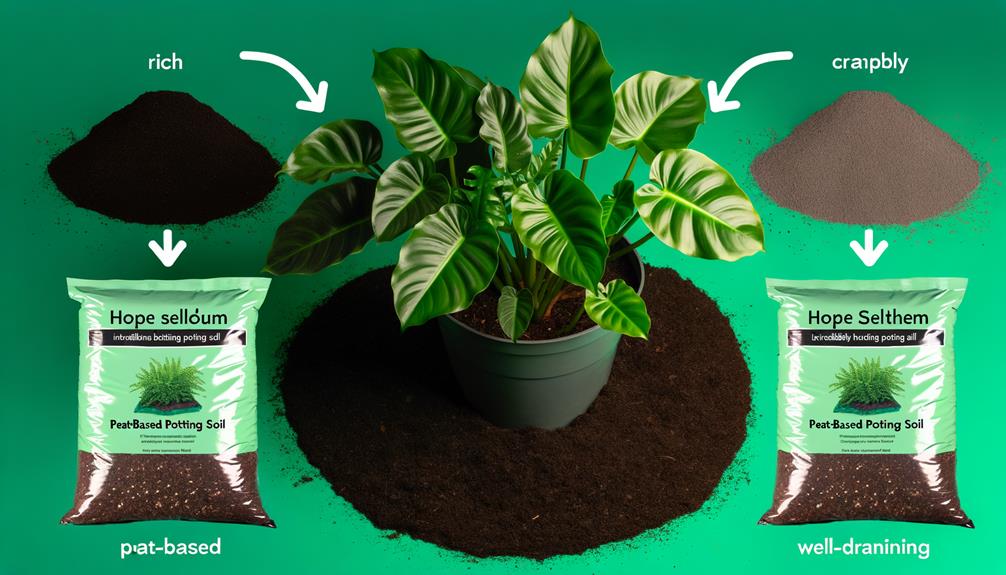
Philodendrons need a specific type of soil to thrive, one that balances adequate drainage with sufficient moisture retention. Selecting the right soil mix is essential, involving a combination of peat, perlite, and organic matter.
Additionally, improving soil quality naturally through the incorporation of compost or worm castings can greatly benefit the plant’s health and growth.
Understanding Philodendron Soil Needs
To ensure the best health and growth of your Hope Selloum Philodendron, a thorough understanding of its unique soil requirements is necessary.
This tropical plant thrives in well-draining soil with a slightly acidic pH level between 6.0 and 7.0.
The soil should be rich in organic matter, which promotes the retention of moisture without causing waterlogging.
Philodendrons are epiphytic, meaning they naturally grow on other plants rather than in soil. Therefore, their roots require plenty of aeration, which can be achieved by incorporating ingredients such as perlite, coarse sand, or bark chips into the soil.
These components prevent soil compaction, facilitating oxygenation and promoting healthy root development, essential for the plant’s overall wellbeing.
Choosing The Right Soil
Selecting an ideal soil mix for your Hope Selloum Philodendron is an important step that can greatly influence the plant’s growth and health.
The soil should be well-draining, yet capable of retaining enough moisture to sustain the plant. A commercial mix intended for indoor plants can be a good starting point. However, for best results, a blend of peat moss, perlite, and garden soil is recommended.
The peat moss promotes moisture retention while adding richness to the soil. Perlite, a volcanic glass, enhances drainage, preventing water-logging and root rot. Finally, garden soil provides essential nutrients.
Guarantee a pH range between 6.0 and 7.0 – philodendrons prefer slightly acidic to neutral soil. Always choose a high-quality organic soil for a thriving philodendron.
Improving Soil Quality Naturally
In the pursuit of best soil health for your Hope Selloum Philodendron, natural amendments and techniques can substantially enhance the quality, fertility, and structure of the soil.
Organic matter, such as compost or well-rotted manure, can be incorporated into the existing soil to increase its nutrient content and improve its physical properties.
The application of mulch can help retain soil moisture and regulate soil temperature, which are both critical for the plant’s root health.
Additionally, the presence of beneficial soil microorganisms can be promoted through the addition of mycorrhizal fungi, which form symbiotic relationships with the plant’s roots, enhancing nutrient uptake.
Proper Fertilization Techniques
How can one ensure optimal growth and health for a Hope Selloum Philodendron? Proper fertilization methods, rooted in a scientific understanding of plant nutrition, are vital. To support this, we suggest using a well-rounded liquid fertilizer, abundant in macronutrients (nitrogen, phosphorus, and potassium), and micronutrients (iron, manganese, and zinc).
We recommend fertilizing once every six weeks during the active growth phase, and less often during periods of dormancy. Excessive fertilization can result in salt accumulation and leaf scorch, hence, it is crucial to carefully adhere to the manufacturer’s guidelines.
A summary of these suggestions is outlined in the table below:
| Fertilizer Type | Frequency | Caution |
|---|---|---|
| Well-rounded liquid fertilizer | Every 6 weeks (active growth phase), less often (dormant periods) | Avoid excessive fertilization to prevent salt build-up and leaf scorch |
Pruning and Maintenance Tips
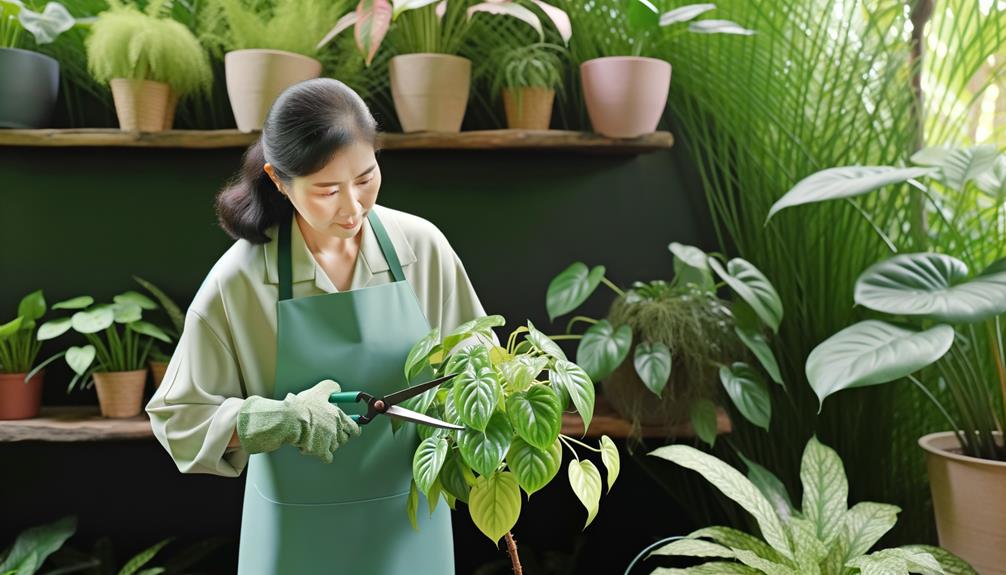
To safeguard the long-term health and aesthetic appeal of your Hope Selloum Philodendron, regular pruning and diligent maintenance are vital. Pruning should be carried out with clean, sharp tools to lessen the risk of disease transmission. Remove dead or yellowing leaves at the base, as they can sap energy from healthier parts.
When pruning, be cautious not to cut into the plant’s main trunk, as this can result in illness or demise. Routinely examine your plant for signs of overgrowth, as this species can grow quite large if not properly handled.
Maintain a consistent watering schedule based on the plant’s specific requirements, and clean the leaves with a damp cloth to eliminate dust and enhance photosynthesis. Ensure your Philodendron is positioned in a suitable spot with adequate lighting and air circulation to prevent disease and foster growth.
Identifying and Treating Pests
In the care of Hope Selloum Philodendrons, one must be attentive in identifying and managing pest infestations.
Pests common to these Philodendrons, such as aphids, mealybugs, and spider mites, can be harmful if left untreated. It is crucial, as a result, to discuss effective treatment methods and strategies for preventing future infestations.
Common Pests on Philodendrons
Despite their hardy nature, Hope Selloum Philodendrons are not immune to infestations from a variety of common pests, including aphids, mealybugs, spider mites, and scale insects. Aphids, tiny insects that feed on plant sap, can cause leaves to curl, yellow, and drop.
Mealybugs, covered in a white, waxy substance, can lead to stunted growth and leaf drop. Spider mites, tiny arachnids, can cause yellowing and speckled leaves. Scale insects, which attach themselves to plant stems and leaves, can cause yellowing and wilting.
Spotting these pests early is essential, with signs including leaf discoloration, stickiness on the plant or nearby surfaces, and visible pests or their residue. Regular inspection and prompt action will help maintain the health of your Hope Selloum Philodendron.
Effective Pest Treatment Methods
Fighting pests on your Hope Selloum Philodendron requires a thorough understanding of effective identification and treatment methods.
- Identification: The first step involves accurately identifying the pest. Common culprits include aphids, spider mites, and mealy bugs. Look for signs of infestation such as leaf discoloration, wilting, or visible insects.
- Treatment: Using a gentle insecticidal soap or neem oil solution can effectively eliminate many common pests. Apply the treatment thoroughly, making sure to cover all leaf surfaces.
- Monitoring: Regularly inspect your plant for signs of re-infestation. Immediate treatment is essential to prevent further plant damage.
Preventing Future Infestations
After successfully treating an initial pest infestation, proactive measures must be taken to deter future invasions and guarantee the long-term health of your Hope Selloum Philodendron.
Regularly inspect your plant for pests, targeting the undersides of leaves and stem junctions where pests often hide. Use a magnifying glass if necessary. Early detection and treatment are essential to prevent severe infestations.
Biological control methods, such as introducing beneficial insects like ladybugs and lacewings, can also be effective. If pests are detected, apply a mild, organic insecticidal soap or neem oil to all leaf surfaces.
Always isolate infested plants to prevent pest spread. Maintain ideal growing conditions and plant health, as pests are often attracted to stressed plants.
Signs of Common Diseases
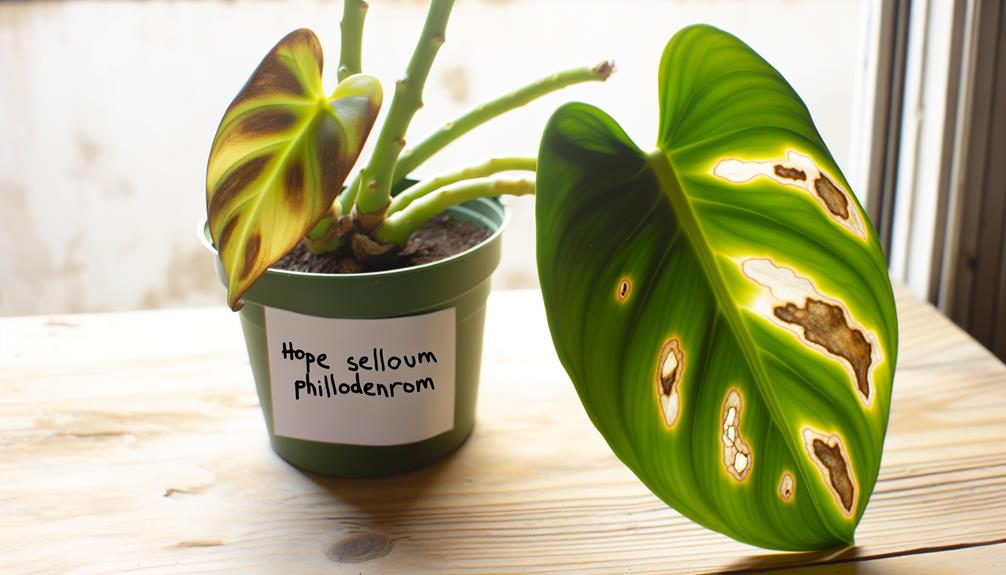
In the journey of nurturing a Hope Selloum Philodendron, it is important to recognize the signs of common diseases that can affect this plant species.
- Leaf Spot: This disease manifests as brown or black spots on the leaves. It is caused by a bacterial or fungal infection and may lead to severe leaf drop if not treated promptly.
- Root Rot: An overwatered Philodendron may develop root rot. The signs include yellowing leaves, wilted growth, and a foul smell from the potting soil.
- Bacterial Blight: This disease causes dark, water-soaked lesions on leaves and stems. It progresses rapidly and can cause severe damage to the plant.
Propagation of Hope Selloum Philodendrons
The propagation of Hope Selloum Philodendrons, a critical aspect of their care, can be explored through three key areas.
- First, we need to understand the fundamental principles that govern this process.
- Then, we’ll discuss how to prepare for propagation, and finally, we’ll provide scientifically-backed tips to guarantee successful propagation outcomes.
Understanding Propagation Basics
Propagating a Hope Selloum Philodendron involves the growth of new plants from sources like seeds, cuttings, and plant parts. This process requires a deep understanding of its unique biological characteristics and growth requirements.
- The first step is identifying the best source material, such as stem or leaf cuttings known for their robust nature and root production ability.
- Next, understanding the growth conditions is crucial. This includes maintaining consistent warmth, high humidity, and indirect light.
- Lastly, being familiar with the propagation timeline is essential. Expect a new plant to emerge after a few weeks of monitored growth.
Preparing for Plant Propagation
Before starting the propagation of a Hope Selloum Philodendron, thorough preparation is essential. This includes gathering appropriate materials and creating an ideal environment for successful growth. Careful selection of a healthy parent plant and using sterilized cutting tools are crucial steps. It is also beneficial to prepare a suitable potting mix, typically a well-draining blend of peat moss and perlite.
The environment for propagation should replicate the tropical conditions in which the philodendron thrives. This includes high humidity, temperatures between 70-85°F, and indirect, bright light. Proper attention to these preparatory steps can significantly influence the success of propagation. This, in turn, contributes to meeting the growth requirements of this beautiful tropical plant, ultimately leading to a gratifying experience.
Successful Propagation Tips
Having adequately prepared for the process, we can now explore the specific techniques for successful propagation of Hope Selloum Philodendrons.
The following three steps are critical:
- Cutting Selection: Identify a healthy parent plant and select a stem 3-6 inches long with at least two nodes. The cut should be made at a 45-degree angle to increase the surface area for rooting.
- Rooting: Dip the cut end in a rooting hormone then plant in a mixture of perlite and peat moss. Maintain high humidity and temperatures between 70-75°F to encourage root development.
- Transplanting: Once the cutting has developed a robust root system, it can be transplanted into a larger pot or directly into the garden, depending on your local climate and personal preference.
Repotting Your Philodendron Plant
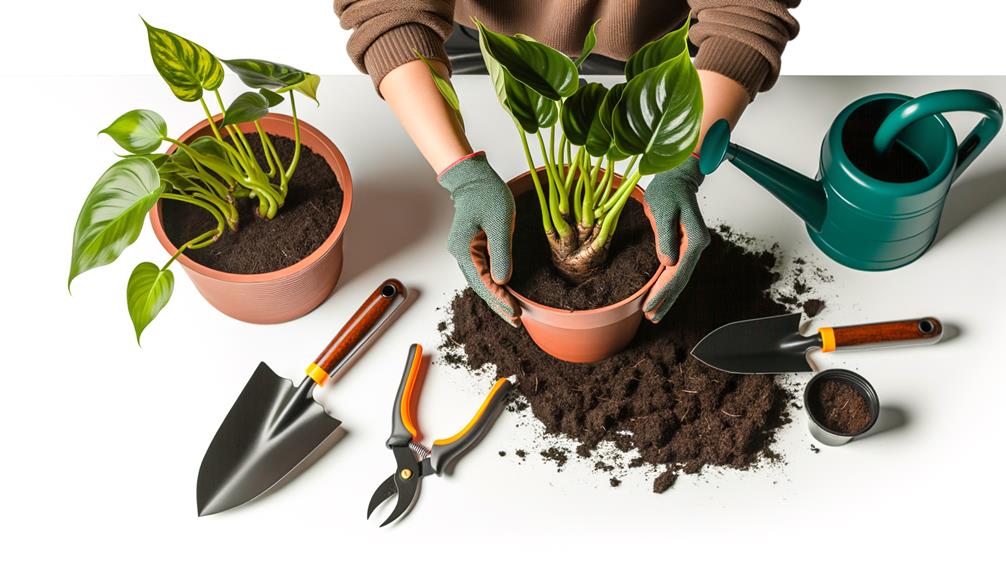
When it becomes necessary to repot your Hope Selloum Philodendron, you should approach the process with a scientific and methodical mindset, understanding that precision, attention to detail, and accuracy are paramount. Choose a pot that is 2-3 inches larger in diameter than the current one. The pot should have sufficient drainage holes to prevent water stagnation.
Here is a three-step guide:
| Steps | Description | Tools Needed |
|---|---|---|
| 1. | Gently remove the plant from its current pot, taking care not to damage the roots. | Gardening Gloves |
| 2. | Fill the new pot with a quality potting mix, ensuring it is well-draining. | Potting Mix |
| 3. | Place the plant in the new pot, spreading the roots gently before adding more soil. | New Pot |
Ensure the plant is watered thoroughly after repotting and placed in a suitable location.
Philodendron Bip Selloum Hope
The Philodendron bipinnatifidum, also known as Philodendron selloum or Tree Philodendron, is a popular houseplant that is often referred to as Philodendron ‘Hope’ or ‘Selloum’. Despite the similar names, the Philodendron Hope is actually a different plant, usually labeled as Thaumatophyllum bipinnatifidum.
To clarify, the Philodendron Hope is a climbing or trailing plant with perforated leaves that are segmented or split. The Philodendron Selloum, on the other hand, is a non-climbing plant with large, solid, waxy leaves that are often found indoors as a floor plant.
In summary, the key characteristics of Philodendron ‘Hope’ are:
- It is a cultivar or man-made hybrid, not a true species.
- It has a bushy growth habit rather than a vining tendency.
- Its leaves are large and dark green with perforated leaf segments.
- It is relatively compact and slow-growing compared to other philodendrons.
So in essence, while the two plants have similar names, a Philodendron ‘Hope’ is quite distinct from a Philodendron Selloum in terms of its growth habit and appearance. Hopefully this clarifies the difference between them!
Conclusion
To wrap up, the Hope Selloum Philodendron displays an impressive ability to adjust to different conditions, making it a favored option among indoor plant enthusiasts.
With the right care, such as adequate lighting, temperature, and moisture levels, this tropical plant can flourish indoors.
Notably, a study indicates that indoor plants such as the Philodendron can enhance air quality by eliminating toxins, emphasizing not just their beauty but also their health advantages.


